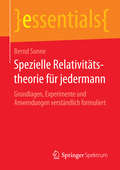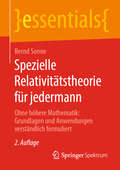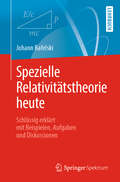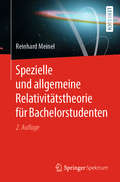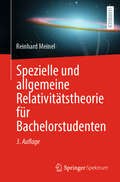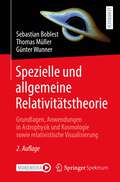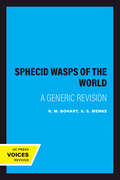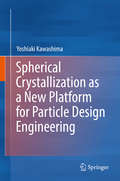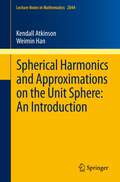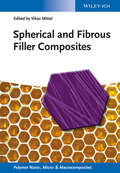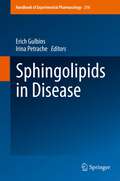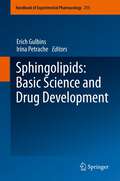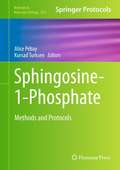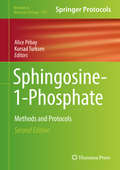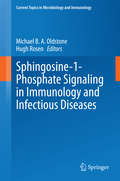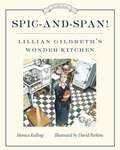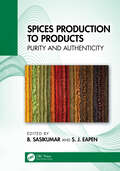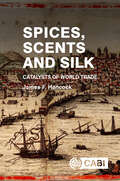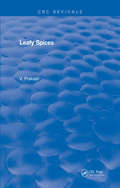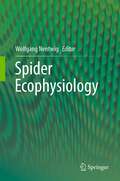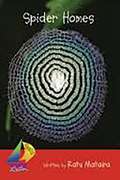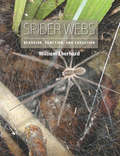- Table View
- List View
Spezielle Relativitätstheorie für jedermann: Grundlagen, Experimente und Anwendungen verständlich formuliert (essentials)
by Bernd SonneBernd Sonne befasst sich mit der Speziellen Relativitätstheorie (SRT) Albert Einsteins. Dabei werden die Theorien des wohl bedeutendsten Physikers des 20. Jahrhunderts, der unser physikalisches Weltbild revolutionierte, für jedermann auch ohne spezielle Vorkenntnisse nachvollziehbar. In einem historischen Rückblick geht der Autor zunächst darauf ein, wie es überhaupt zur SRT gekommen ist – Kernpunkt ist dabei das berühmte Experiment von Michelson und Morley Ende des 19. Jahrhunderts. Daraufhin stellt er die Prinzipien der SRT vor und geht auf die Äquivalenz von Masse und Energie ein. Anschauliche Beispiele aus der Praxis verdeutlichen die Ausführungen. Einige Paradoxa, die mit der SRT verbunden sind, werden widerspruchsfrei aufgelöst.
Spezielle Relativitätstheorie für jedermann: Ohne höhere Mathematik: Grundlagen und Anwendungen verständlich formuliert (essentials)
by Bernd SonneBernd Sonne befasst sich in diesem essential mit der Speziellen Relativitätstheorie (SRT) Albert Einsteins. Die Theorien des wohl bedeutendsten Physikers des 20. Jahrhunderts, der unser physikalisches Weltbild revolutionierte, werden für jedermann auch ohne spezielle Vorkenntnisse nachvollziehbar erläutert. In einem historischen Rückblick geht der Autor zunächst darauf ein, wie es zur SRT gekommen ist. Daraufhin stellt er die Prinzipien der SRT vor und geht auf die Äquivalenz von Masse und Energie ein. Anschauliche Beispiele aus der Praxis verdeutlichen die Ausführungen. Einige Paradoxa, die mit der SRT verbunden sind, werden widerspruchsfrei aufgelöst. Die zweite Auflage wurde um weitere Themen ergänzt, wie beispielsweise Aberration sowie die Erzeugung von Röntgenstrahlung.
Spezielle Relativitätstheorie heute: Schlüssig erklärt mit Beispielen, Aufgaben und Diskussionen
by Johann RafelskiDieses Lehrbuch bietet eine in der Form neue und einmalige Darstellung der speziellen Relativitätstheorie, in der präzise und nachvollziehbar die Grundlagen entwickelt und dabei zahlreiche gängige Missverständnisse zu vermeintlichen Folgerungen aus der Theorie ausgeräumt werden. Hier wird die Relativitätstheorie so präsentiert, dass nichts paradox oder unklar bleibt.Neben der sorgfältigen, elementaren Einführung mit zahlreichen Übungen, vorgerechneten Beispielen und vielen Diskussionen zu konzeptionellen Fragen knüpft dieser Band auch an aktuelle Forschungsthemen an, so dass die Leser die spezielle Relativitätstheorie von den Grundlagen bis zu ihren Grenzen erkunden können. Auf die Verwendung des Tensorkalküls und von Vierervektoren verzichtet das Buch, um damit verbundene zusätzliche Schwierigkeiten zu vermeiden. Das Werk präsentiert somit die spezielle Relativitätstheorie so, dass die Einstiegskapitel von Erstsemestern verwendet werden können. Dank zunehmender Vertiefung der Themen in den nachfolgenden Kapiteln bleibt es für Physikstudierende bis zum Bachelor ein wertvoller Begleiter.
Spezielle und allgemeine Relativitätstheorie für Bachelorstudenten
by Reinhard MeinelDas vorliegende Buch bietet eine gut verständliche Einführung in die spezielle und allgemeine Relativitätstheorie und zeigt einen Weg auf, wie beide Themen standardmäßig in das Bachelorstudium der Physik integriert werden können. Damit richtet es sich in erster Linie an Studenten beziehungsweise Dozenten der Physik einschließlich des Physik-Lehramtes. Dank der zahlreichen Übungsaufgaben mit ausführlich dargestellten Lösungen ist es auch zum Selbststudium geeignet, wobei lediglich Grundkenntnisse der klassischen Mechanik und der Elektrodynamik sowie der zugehörigen mathematischen Hilfsmittel vorausgesetzt werden.Die ersten beiden Teile dieses Buches basieren auf der Vorlesung zur Relativitätstheorie, die der Autor seit 2007 regelmäßig und mit großem Erfolg für Bachelorstudenten der Physik in Jena anbietet. Darin werden die Grundlagen der SRT (Lorentz-Transformationen, Vierervektoren, relativistische Punktmechanik) und der ART (Krümmung der Raumzeit, Einstein’sche Feldgleichungen, Schwarzschild-Lösung) behandelt. Im dritten Abschnitt werden als „Ergänzungen für Fortgeschrittene“ mathematische Methoden dargestellt, die unter anderem eine systematische Lösung des Randwertproblems der Einstein-Maxwell-Gleichungen für ein stationäres Schwarzes Loch gestatten. Auf diese Weise wird – erstmals in einem Lehrbuch – eine physikalische Herleitung der berühmten Kerr-Newman-Lösung gegeben.Für die vorliegende zweite Auflage wurde der Abschnitt über Gravitationswellen aktualisiert und erweitert sowie eine Reihe kleiner Verbesserungen vorgenommen.
Spezielle und allgemeine Relativitätstheorie für Bachelorstudenten
by Reinhard MeinelDieses Lehrbuch bietet bereits im Bachelorstudium einen gut verständlichen Zugang nicht nur zur speziellen, sondern auch zur allgemeinen Relativitätstheorie. Besonderheiten: Erstmals in einem Lehrbuch wird eine physikalische Herleitung der berühmten Kerr-Newman-Lösung gegeben. Dank der zahlreichen Übungsaufgaben mit ausführlich dargestellten Lösungen ist das Buch auch zum Selbststudium geeignet. Inhalt: Einführung – Der Minkowski-Raum, die Raumzeit der SRT – Lorentz-Transformationen – Vierervektoren und Vierertensoren – Relativistische Punktmechanik – Andere Teilgebiete der Physik im Rahmen der SRT – Grundideen der ART – Geometrie der Raumzeit – Physik in der gekrümmten Raumzeit – Die Einstein'schen Feldgleichungen – Der Newton'sche Grenzfall – Die Schwarzschild-Lösung – Die klassischen Effekte der ART – Kugelsymmetrische Sternmodelle – Die Schwarzschild-Lösung als Schwarzes Loch – Das Wirkungsprinzip der ART – Ausblick auf Gravitationswellen, Kosmologie und Quantengravitation – Mathematische Methoden – Rotierende und elektrisch geladene Schwarze Löcher – Die rotierende Staubscheibe Neuerungen (3. Aufl.): Neben neuen Aufgaben und Lösungen wurde auch ein Abschnitt zur Thermodynamik Schwarzer Löcher hinzugefügt. Zielgruppe: Studierende und Lehrende der Physik, sowohl im Hauptstudium als auch im Lehramtsstudium Vorkenntnisse: Vorausgesetzt werden lediglich Grundkenntnisse der klassischen Mechanik und der Elektrodynamik sowie der zugehörigen mathematischen Hilfsmittel.
Spezielle und allgemeine Relativitätstheorie: Grundlagen, Anwendungen in Astrophysik und Kosmologie sowie relativistische Visualisierung
by Thomas Müller Sebastian Boblest Günter WunnerDieses Lehrbuch verknüpft die mathematischen Grundlagen der speziellen und allgemeinen Relativitätstheorie mit zahlreichen Anwendungsgebieten aus Physik und Astronomie. Neben der Diskussion von klassischen Experimenten, welche die Vorhersagen der Relativitätstheorie bestätigen, wird ein Fokus auf die Kosmologie als Anwendung der Relativitätstheorie gesetzt. Die Behandlung der Physik kompakter stellarer Objekte, d. h. von weißen Zwergen, Neutronensternen und Schwarzen Löchern, mit einem kurzen Abschnitt zur Entstehung und Entwicklung von Sternen runden die Darstellung ab.Einen besonderen Schwerpunkt legen die Autoren auf die relativistische Visualisierung. In zwei Kapiteln bekommt der Leser einen Überblick über verschiedene Techniken in der speziellen und allgemeinen Relativitätstheorie. Anhand von Beispielen können die der Alltagserfahrung scheinbar widersprechenden Vorhersagen der Relativitätstheorie besser fassbar gemacht werden. Die daraus gewonnenen Abbildungen und begleitenden Videos, die über die SN More Media App zugänglich sind, erweitern das Verständnis der im Text behandelten Themen.In der vorliegenden zweiten Auflage haben die Autoren vor allem neuere Entwicklungen (z.B. zum Thema Gravitationswellen) aufgenommen und zudem viele kleinere Verbesserungen und Ergänzungen vorgenommen. Das Buch richtet sich besonders an Studierende der Physik und verwandter Studiengänge, die sich einen Überblick über die Relativitätstheorie und ihre Anwendungsgebiete verschaffen möchten, aber auch interessierte Laien können damit interessante Einsichten gewinnen.
Sphecid Wasps of the World: A Generic Revision
by R. M. Bohart A. S. MenkeThis title is part of UC Press's Voices Revived program, which commemorates University of California Press’s mission to seek out and cultivate the brightest minds and give them voice, reach, and impact. Drawing on a backlist dating to 1893, Voices Revived makes high-quality, peer-reviewed scholarship accessible once again using print-on-demand technology. This title was originally published in 1976.
Spherical Crystallization as a New Platform for Particle Design Engineering
by Yoshiaki KawashimaThis book describes the principles and applications of the spherical crystallization technique, from the standpoint of its inventor. After an introduction on the history of particle design engineering and nanotechnology, the concept of spherical crystallization itself is clearly explained. Attention then turns to the application of spherical crystallization in pharmaceutical processes. It is explained how the technique can provide physicochemical properties suitable for direct tableting of active pharmaceutical ingredients and how it has enabled the development of a novel particulate design platform from single to complex system. Subsequent chapters describe the roles of polymeric spherical crystallization in the preparation of novel microspheres, microballoons for drug delivery systems (DDS) and the development of biocompatible and biodegradable poly(D,L-lactide-co-glycolide) (PLGA) nanospheres. The various applications of PLGA nanospheres composite within oral-, pulmonary-, transdermal DDS and cosmetics are fully discussed. Finally, future perspectives are presented on use of the technology in the design and industrial-scale manufacture of new drug delivery systems, highlighting how a continuous pharmaceutical process that meets US Food and Drug Administration quality requirements should soon be introduced.
Spherical Harmonics and Approximations on the Unit Sphere: An Introduction
by Kendall Atkinson Weimin HanThese notes provide an introduction to the theory of spherical harmonics in an arbitrary dimension as well as an overview of classical and recent results on some aspects of the approximation of functions by spherical polynomials and numerical integration over the unit sphere. The notes are intended for graduate students in the mathematical sciences and researchers who are interested in solving problems involving partial differential and integral equations on the unit sphere, especially on the unit sphere in three-dimensional Euclidean space. Some related work for approximation on the unit disk in the plane is also briefly discussed, with results being generalizable to the unit ball in more dimensions.
Spherical and Fibrous Filler Composites
by Vikas MittalScrutinizing various fillers, such as fly ash, inorganic nanoparticles, Kevlar and wood flour, this book exemplifies how the choice of filler influences the micro- and macroscopic behavior of the resulting polymer composites, such as friction, wear and impact resistance. In so doing, the text brings together a number of composite systems using different polymer matrices, different filler systems as well as different processing conditions, thereby serving as a beneficial guide for readers so as to select a particular set of processing conditions or composite constituents for the enhancement of certain properties.
Sphingolipids in Disease
by Irina Petrache Erich GulbinsSphingolipids are lipid components of the plasma membrane of eukaryotic cells with an important function in signaling mechanisms in the cell. This book provides insight into the physiological and pathophysiological role of sphingolipids and in particular its derivative ceramide. The function of Sphingolipids in cell signaling with regard to infectious and lung diseases, cancer, cardiovascular diseases and neuropsychiatric disorders are described and treated in distinct parts. Together with Volume 215 from the same Editors, the collection represents a unique, comprehensive work on Sphingolipids, providing information on both: Sphingolipid basic biology as well as its important function in a (patho)physiological context. The book is written for scientists in pharmacology, biochemistry and cell biology with a focus on biomedical research as well as for clinicians in pharmacology, oncology, cardiology, neurology and infectious disease.
Sphingolipids: Basic Science and Drug Development
by Irina Petrache Erich GulbinsSphingolipids are lipid components of the plasma membrane in eukaryotic cells. They have an important function in signaling mechanisms in the cell. This book on sphingolipids provides insights into the basics of sphingolipid biology and drug development, with a particular emphasis on the sphingolipid derivative ceramide. In the first part basic functions of sphingolipids are described, as well as the genetics of important enzymes, sphingolipid metabolism and synthesis. The second part of this first volume focuses on drug development and pharmacology. The book is intended for scientists in pharmacology, biochemistry and cell biology with a focus on biomedical research as well as for clinicians working in pharmacology, oncology, cardiology, neurology and infectious disease. Together with Volume 216 by the same editors, the collection represents a unique, comprehensive work on sphingolipids, providing information on both sphingolipids' basic biology (including synthesis, metabolism and cell biology) and their important function in a (patho-)physiological context.
Sphingosine-1-Phosphate
by Kursad Turksen Alice PébaySphingosine-1-phosphate is a bioactive lysophospholipid which has become, in recent years, the focus of much research interest as it has widespread developmental and physio-pathological actions, controlling events within the nervous, reproductive, gastrointestinal, vascular, respiratory, and immune systems, in addition to having a prominent role in cancer, early mammalian embryogenesis, and stem cells. In Sphingosine-1-Phosphate: Methods and Protocols, worldwide experts in the S1P field describe in-depth techniques in an array of cell types and with various physiological applications, showcasing the important effects of S1P in development and in physiopathology. As a volume in the Methods in Molecular BiologyTM series, chapters contain introductions to their respective topics, lists of the relevant materials and reagents, step-by-step, readily reproducible laboratory protocols, and tips for troubleshooting and avoiding known pitfalls. Authoritative and timely, Sphingosine-1-Phosphate: Methods and Protocols is a key resource for scientists working in this expanding and dynamic field.
Sphingosine-1-Phosphate
by Kursad Turksen Alice PébaySphingosine-1-phosphate is a bioactive lysophospholipid which has become, in recent years, the focus of much research interest as it has widespread developmental and physio-pathological actions, controlling events within the nervous, reproductive, gastrointestinal, vascular, respiratory, and immune systems, in addition to having a prominent role in cancer, early mammalian embryogenesis, and stem cells. In Sphingosine-1-Phosphate: Methods and Protocols, worldwide experts in the S1P field describe in-depth techniques in an array of cell types and with various physiological applications, showcasing the important effects of S1P in development and in physiopathology. As a volume in the Methods in Molecular Biology(tm) series, chapters contain introductions to their respective topics, lists of the relevant materials and reagents, step-by-step, readily reproducible laboratory protocols, and tips for troubleshooting and avoiding known pitfalls. Authoritative and timely, Sphingosine-1-Phosphate: Methods and Protocols is a key resource for scientists working in this expanding and dynamic field.
Sphingosine-1-Phosphate Signaling in Immunology and Infectious Diseases
by Hugh Rosen Michael B. A. OldstoneThis volume focuses on the role of sphingosine-1-phosphate (S1P) and its analogs in the induced sequestration of lymphocytes in secondary lymphoid organs or in the microenvironment of tissues involved in infection or autoimmune disease. Initial chapters define the pathways to understand S1P signaling. They cover the organization of signaling systems, the structural biology of the S1P1 receptor, and the chemical and genetic tools that are available and useful to explore this area of research and therapeutics. The later chapters highlight S1P and endothelial integrity, lymphocyte migration in the spleen, and S1P agonist in controlling immunopathologic manifestations of acute respiratory influenza virus infection (in the lung), and its accompanying cytokine storm as well as immunopathologic disease of the central nervous system, including the beginning of treatments in multiple sclerosis. One chapter reveals the possible involvement of other lipid molecules, their use for better understanding lipid signaling, and their potential in the modulation of immune responses.
Spi-ku: A Clutter of Short Verse on Eight Legs
by Leslie BulionLeslie Bulion, award-winning educator favorite and master of science poetry, is back with a humorous exploration of the silk-spinning, bungee-jumping, hunting, trapping, trick-filled world of spiders!Meet spiders that spit silk, roll like wheels, scuba dive, hide under trap doors, strum tunes, and so much more. Watch as they find mates, find prey...or find mates that become prey!Award-winning poet Leslie Bulion and illustrator Robert Meganck team up again for this clutter (a collective noun for spiders) of short poems and humorously accurate illustrations celebrating the amazing attributes of Araneae. The book is also packed with helpful sidebars, call-outs, and back matter, including a glossary of science terms, a description of the poetic forms, a list of common and scientific names, a spider-hunting adventure how-to, resources for further study, and a relative-size chart. A feast for science and animal fans!
Spic-and-Span!: Lillian Gilbreth's Wonder Kitchen (Great Idea Series #6)
by Monica KullingBorn into a life of privilege in 1878, Lillian Moller Gilbreth put her pampered life aside for one of adventure and challenge. She and her husband, Frank, became efficiency experts by studying the actions of factory workers. They ran their home efficiently, too. When Frank suddenly died, Lillian was left to her own devices to raise their eleven children. Eventually, she was hired by the Brooklyn Borough Gas Company to improve kitchen design, which was only the beginning. Lillian Gilbreth was the subject of two movies (Cheaper by the Dozen and Belles on Their Toes), the first woman elected to the National Academy of Engineering, and the first female psychologist to have a U.S. postage stamp issued in her honor. A leading efficiency expert, she was also an industrial engineer, a psycologist, an author, a professor, and an inventor.
Spices Production to Products: Purity and Authenticity
by S. J. EapenIn a globally connected market, ensuring the purity and authenticity of spices is more critical than ever. Spices Production to Products: Purity and Authenticity addresses the challenges of spice adulteration and contamination that threaten food safety, public health, forex earnings, and the integrity of global supply chains. Despite advancements in agriculture, processing, and regulations, spices remain vulnerable to fraud and environmental contaminants.This comprehensive volume explores various adulterants and contaminants compromising spice quality and safety, presenting state-of-the-art detection methods and containment strategies. Combining historical insights with cutting-edge research, it provides a thorough understanding of intentional and unintentional adulteration.Key Features: In-Depth Analysis: Chapters on testing black pepper, chilli, ginger, nutmeg, saffron, and turmeric Advanced Detection Methods: Techniques for identifying mycotoxins, pesticides, and heavy metals Comprehensive Coverage: Focus on consumer awareness, supply chain management, and sustainability Global Standards: Insights into regulatory frameworks and harmonization efforts Practical Strategies: Tools for detection and mitigation tailored to professionals and researchers This indispensable resource is designed for regulatory agencies, food industry professionals, researchers, policymakers, and informed consumers. Whether detecting adulterants, developing technologies, or advocating for higher standards, this book equips you to address the complexities of spice purity and authenticity.
Spices, Scents and Silk: Catalysts of World Trade
by James HancockSpices, scents and silks were at the centre of world trade for millennia. Exotic luxuries such as cinnamon, ginger, pepper, saffron, clove, frankincense and myrrh. Through their international trade, humans were pushed to explore and then travel to the far corners of the earth. Almost from their inception, the earliest great civilizations - Egypt, Sumer and Harappa - became addicted to the luxury products of far-off lands and established long-reaching trade networks. Over time, great powers fought mightily for the kingdoms where silk, spices and scents were produced. The New World was accidentally discovered by Columbus in his quest for spices. What made trade in these products so remarkable was that the plants producing them grew in very restricted areas of the world, distant from the wealthy civilizations of northern Africa, Greece and Europe. These luxuries could be carried from mysterious locations on the backs of camels or in the holds of ships for months on end, and arrived at their final destination in nearly perfect condition. Once the western world discovered the intoxicating properties of these products, their procurement became a dominant force in the world economy. Nothing else compared with their possible profit returns. In this book, eminent horticulturist and author James Hancock examines the origins and early domestication and culture of spices, scents and silks and the central role they played in the lives of the ancients. The book also traces the development of the great international trade networks and explores how struggles for trade dominance and demand for such luxuries shaped the world. Recommended for academics, students and general readers with an interest in crop and agricultural development, world trade, economic botany, history of food, and global economics and public policy, Spices, Scents and Silk offers a fascinating and insightful history.
Spices: Leafy Spices
by V. PrakashLeafy Spices discusses the botany, cultivation, harvesting and processing, chemical composition, processing methods, varietal differences and end uses for the leaves and essential oils of leafy spices. The book emphasizes botany and cultivation, identifies which seasons are best for harvesting to achieve a maximum oil yield, and explains the care needed to ensure successful cultivation and oil extraction. Leaf and oil composition is discussed, and the medicinal uses of the leaves, as well as their use as food flavorings, are examined in detail. Species covered include basil, bay, bergamot, borage, burnet, capers, camomile, chervil, chives, coriander, costmary, curry leaf, marjoram, mint, oregano, parsley, rosemary, sage, savory, tarragon, and thyme. This book is an ideal reference volume for botanists, food scientists, technologists, and flavor chemists.
Spider Behaviour: Flexibility and Versatility
by Marie Elisabeth HerbersteinSpiders are often underestimated as suitable behavioural models because of the general belief that due to their small brains their behaviour is innate and mostly invariable. Challenging this assumption, this fascinating book shows that rather than having a limited behavioural repertoire, spiders show surprising cognitive abilities, changing their behaviour to suit their situational needs. The team of authors unravels the considerable intra-specific as well as intra-individual variability and plasticity in different behaviours ranging from foraging and web building to communication and courtship. An introductory chapter on spider biology, systematics and evolution provides the reader with the necessary background information to understand the discussed behaviours and helps to place them into an evolutionary context. Highlighting an under-explored area of behaviour, this book will provide new ideas for behavioural researchers and students unfamiliar with spiders as well as a valuable resource for those already working in this intriguing field.
Spider Ecophysiology
by Wolfgang NentwigWith over 43,000 species, spiders are the largest predacious arthropod group. They have developed key characteristics such as multi-purpose silk types, venoms consisting of hundreds of components, locomotion driven by muscles and hydraulic pressure, a highly evolved key-lock mechanism between the complex genital structures, and many more unique features. After 300 million years of evolutionary refinement, spiders are present in all land habitats and represent one of the most successful groups of terrestrial organisms. Ecophysiology combines functional and evolutionary aspects of morphology, physiology, biochemistry and molecular biology with ecology. Cutting-edge science in spiders focuses on the circulatory and respiratory system, locomotion and dispersal abilities, the immune system, endosymbionts and pathogens, chemical communication, gland secretions, venom components, silk structure, structure and perception of colours as well as nutritional requirements. Spiders are valuable indicator species in agroecosystems and for conservation biology. Modern transfer and application technologies research spiders and their products with respect to their value for biomimetics, material sciences, and the agrochemical and pharmaceutical industries.
Spider Homes (Rigby Sails #Red (Level 3-5))
by Ratu MatairaLearn more about all the different places spiders can live.
Spider Silk: Evolution and 400 Million Years of Spinning, Waiting, Snagging, and Mating
by Leslie Brunetta Catherine L. CraigSpiders, objects of eternal human fascination, are found in many places: on the ground, in the air, and even under water. Leslie Brunetta and Catherine Craig have teamed up to produce a substantive yet entertaining book for anyone who has ever wondered, as a spider rappelled out of reach on a line of silk, "How do they do that?" The orb web, that iconic wheel-shaped web most of us associate with spiders, contains at least four different silk proteins, each performing a different function and all meshing together to create a fly-catching machine that has amazed and inspired humans through the ages. Brunetta and Craig tell the intriguing story of how spiders evolved over 400 million years to add new silks and new uses for silk to their survival "toolkit" and, in the telling, take readers far beyond the orb. The authors describe the trials and triumphs of spiders as they use silk to negotiate an ever-changing environment, and they show how natural selection acts at the genetic level and as individuals struggle for survival.
Spider Webs: Behavior, Function, and Evolution
by William EberhardIn this lavishly illustrated, first-ever book on how spider webs are built, function, and evolved, William Eberhard provides a comprehensive overview of spider functional morphology and behavior related to web building, and of the surprising physical agility and mental abilities of orb weavers. For instance, one spider spins more than three precisely spaced, morphologically complex spiral attachments per second for up to fifteen minutes at a time. Spiders even adjust the mechanical properties of their famously strong silken lines to different parts of their webs and different environments, and make dramatic modifications in orb designs to adapt to available spaces. This extensive adaptive flexibility, involving decisions influenced by up to sixteen different cues, is unexpected in such small, supposedly simple animals. As Eberhard reveals, the extraordinary diversity of webs includes ingenious solutions to gain access to prey in esoteric habitats, from blazing hot and shifting sand dunes (to capture ants) to the surfaces of tropical lakes (to capture water striders). Some webs are nets that are cast onto prey, while others form baskets into which the spider flicks prey. Some aerial webs are tramways used by spiders searching for chemical cues from their prey below, while others feature landing sites for flying insects and spiders where the spider then stalks its prey. In some webs, long trip lines are delicately sustained just above the ground by tiny rigid silk poles. Stemming from the author’s more than five decades observing spider webs, this book will be the definitive reference for years to come.
